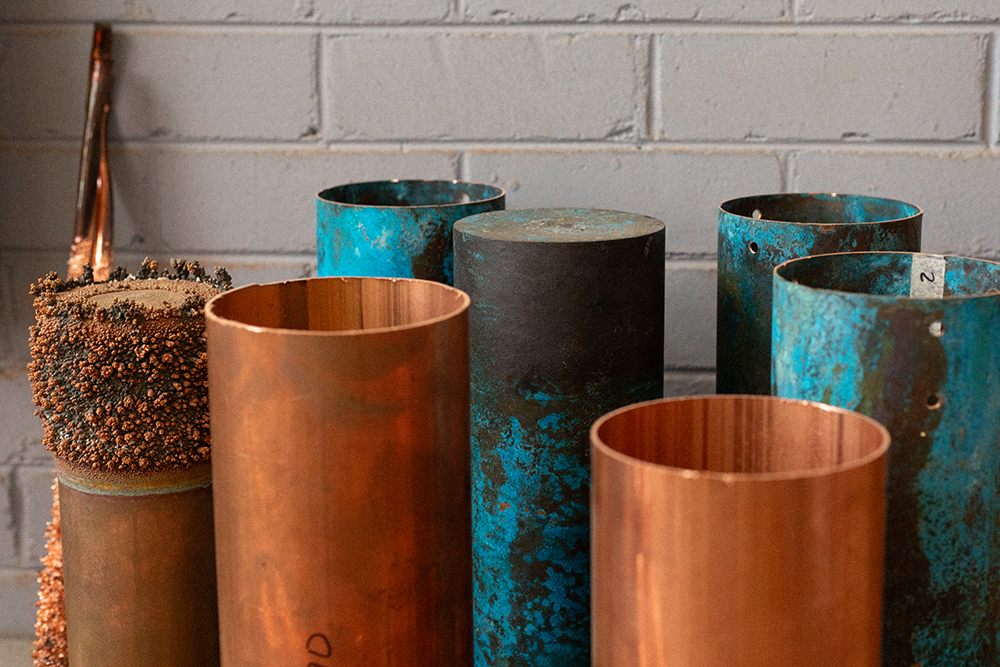‘I love it that it’s slippery. I love the sense that there are those pushing out work that makes you wonder, “Is that sculpture or do I sit on it?” And if it is a sculpture, how does that change how I see it as something that is a container of ideas?’ says Virginia Rigney, curator of the new exhibition at Canberra Museum and Gallery: Materiality… but not as we know it.
This showcase of new and recent works by 10 artists and designers addresses the liminal divide between sculpture and design, hence the title. It considers the ways in which the aged materials that we extract from the earth meet and interact with the new technologies and processes of production that shape our lives.
‘When you see these exhibits, you tend to think, “Well, how is that and why is that?”’ says Rigney, pointing out how the pieces’ strange or unexpected fusions of form pique curiosity.
‘It’s interesting as a curator to see artists intuitively developing work on this kind of level and then at the same time theorists and historians are also writing about it,’ Rigney tells ArtsHub. ‘It’s something that is coming out of their own thinking and pathways. So, it’s a bit of a zeitgeist moment that is quite genuine.’
The artists whose works are on display are Elliot Bastianon, Mel Douglas, Marian Drew, Ashley Eriksmoen, Paul Girrawah House, Lucy Irvine, Trent Jansen, Harriet Schwarzrock, Rebecca Selleck and James Taylor.
Of Bastianon’s work, Rigney says, ‘Elliot’s been working in this climate where we’re concerned with the environment and mining resources, and how we deal with materials that we extract. He was also interested in the concept of rewilding, which is a movement in landscape design where, instead of ordered planting (hedgerows, topiary), there’s a trend in using a whole diversity of plants. So, he took these ideas of landscape and resources, and decided to create something using copper pipes, the ones that carry water and electricity.
‘He’s dipped them into an acid bath and allowed the inherent metal within that material to bubble to the surface and create their own organic incrustations and shapes. And he doesn’t have control over how it looks, unlike woodwork (the discipline where his background lies) where every tiny cut and insertion and nail have to align precisely.’
Then there are the creations of Paul Girrawah House, an Indigenous artist who works with glass ‘so he could maintain that kind of cultural practice, but in a way that reflected his contemporary creativity with new materials’. In this exhibition House has made vibrantly-coloured glass coolamons – multipurpose shallow wooden vessels made and used primarily by women to nurture babies, and carry water and food. The coolamons are arranged so that they appear to float and flow on the wall.
‘Complementing this investigation with materials is a shield House has made out of cast bronze,’ says Rigney. What is regarded as one of the oldest materials in western art making becomes a very new one for this First Nations artist.
Materiality also has an interactive element in terms of Lucy Irvine’s art practice. The Canberra Museum and Gallery is situated in a fantastic location, says Rigney, but it’s hidden.
‘So, we developed this idea of a project that would link the front entrance to the gallery space. Lucy has created these sets of rings that have been designed so people can sit down and thread them together and afterwards they are turned into sculptures that are suspended from the ceiling.’
In terms of curation, Rigney notes that there is plenty of space allocated for these works. ‘I also did not attach too much [in the way of] labels to them. Too often we go into exhibitions and feel the need to read lots of stuff. You don’t necessarily have to know the background to these pieces. Of course, there’s theory involved in all these artists, but you can still connect with their work as an individual. Let your eyes do the work and then the brain will follow.’
Materiality… but not as we know it will be exhibited at the Canberra Museum and Gallery until 20 October 2024.
See the Exhibition for FREE, or check out their bookable behind the scenes experiences here.





